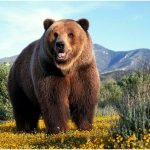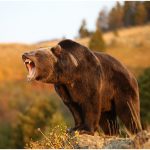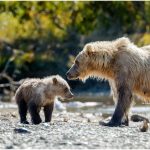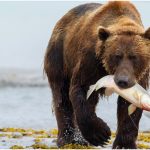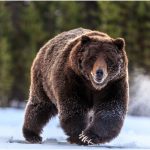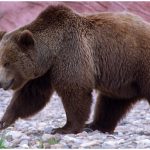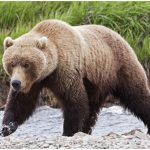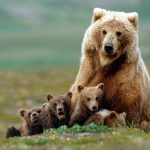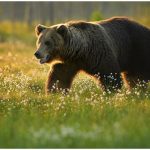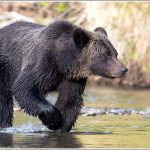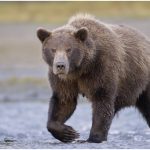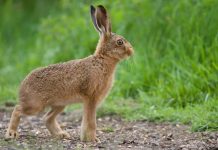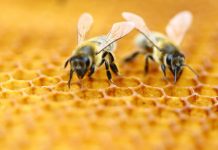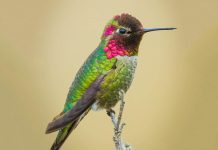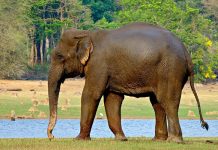The grizzly is an awesome, feared yet admirable animal. It has been acclaimed as the second largest carnivore in North America. This sub-species of the brown bear is a huge animal that can weigh between 300 and 800 pounds.
Some captured ones have been found to weigh as much as 1400 pounds. They can reach up to a height of 8 feet by standing on their hind feet. The grizzly typically measures about 1.8 meters in length from its nose to the end of its tail.
Grizzlies have their origin in Europe and the Asian Continent. Presently they are found in North America and Canada. They can be found in woodlands and forests and also valleys near rivers. They are commonly referred to as:
- Brown bears in Canada and Alaska
- Grizzly in the 48 states of the USA other than Alaska.
Grizzly Bear Interesting Facts For Kids and Information :
- Have brown fur but can be light cream or black
- Furs on its shoulders and the back have white tips that make it appear grizzled. That is why they are called grizzly bears
- They have concave faces
- They are recognizable by the hump on their back which is made of muscles
- They have long claws that they use to claw the ground
- Their long claws and muscled hump help the grizzly when digging into the ground
- Communicate to each other through growls, snorts or roars
- When standing on all its paws, the grizzly can be 3 to 4 feet in height. However, when it stretches to its full height on its hind feet, it can stand up to 8 feet.
Grizzly Bear Diet :
Though sometimes called a carnivorous animal, the grizzly is omnivorous because it eats flesh and vegetables.
- The grizzly’s diet is made of berries, seeds grasses fungi, roots, leaves and nuts.
- Grizzlies also feed on fish, dead animals, elk, deer, rodents, moose and insects
During the period preceding hibernation, for about 2 to 4 months, grizzlies enter a period of multiplying calorie intake in preparation for hibernation. They can eat up to 25 fishes daily and gain as much as 3 pounds of fat each day to act as food reserves during hibernation.
Hibernation :
They can hibernate for 5 to 8 months annually. They eat less and survive on fat reserves accumulated before hibernation. The heart rate and breathing process are slowed down during hibernation and the metabolic processes are also slowed. Grizzlies can wake up any time during hibernation.
Grizzly Bear Population :
Though previously grizzly bears populated the whole range from Alaska to Mexico and Canada to Ohio, the population has shrank from nearly 50,000 in North America to about 1,800 today. Grizzlies are now found in:
- Wyoming
- Montana
- Idaho
- Alaska
- Western Canada and
- some few in Washington
- the tundra among others
Famous Places Where You Can Find Grizzlies :
Grizzlies can be found in Glacier National Park and Yellowstone National park in larger numbers.
Predators :
Did you know that the only predators of grizzlies are the humans?
Grizzlies were massively hunted down in the 1970s and 1980s which greatly depleted their population. Nowadays they are protected by law, therefore hunting grizzlies is illegal. This has contributed to a gradual rise in their population. They have multiplied and moved from endangered species to threatened one, thus making them less vulnerable to being extinct.
Also read: Asiatic Black Bear
Reproduction
Grizzlies take a considerably long time to reproduce. The onset of the grizzlies’ reproduction commences when they are 4 to 5 years old.
- Mating
Their mating season is between late spring and beginning of summer, which is from early May to mid-July. Females usually begin hibernation when they are pregnant. Interestingly, females delay implanting the egg into the uterus till October or November. Just before end of hibernation, the female will cub.
- Gestation
The gestation period lasts between 180 to 270 days. Cubs will continue to be nurtured by the mother till they are 2 to 4 years old. Like many mothers with cubs in the wild, mother bear is very protective of her cubs. She can tear to pieces anyone or anything that comes close to her cubs.
- Litter Size
Grizzlies give birth between 1 and 4 cubs. On average, each female reproduces 2 to 3 cubs.
- Cubs may weigh up to 1 pound
- The cubs are born blind
- Mother bear nurses them till they are about 20 pounds before emerging from hibernation.
- The cubs begin climbing trees from a tender age. After sometime, they lose the ability to climb tree due to elongated claws. A bear’s claws can be as long as a human’s finger.
- When the cubs separate from the mother, the females set their homes close to their mothers while the males may settle a little further away but still not too far from the mother
Images, Pics, Photos, Pictures of Grizzly Bear :
Grizzly Bear Characteristics :
- The grizzly is a very intelligent animal
- Grizzlies can swim like an expert.
- They can run as fast as 50km/h.
- Bears are endowed with a keen eye sight
- They have a heightened sense of smell better than the hound
Grizzly Bear Lifestyle :
Grizzlies live 30 years of their lives in the wild and about 40 years of their life in hibernation.
- Bears are generally solitary animals. This is so especially for the male bear.
- The female bear nurtures her cubs for 2 to 4 years.
- They are not very territorial. Sometimes they can feed together when food is plenty, for instance at salmon streams.
- Bears can live for up to 15 to 20 years
The legendary grizzly is famous for its running speed and agility in swimming, which are surprising considering that it walks in a lumbering manner and it is huge. A grizzly can combine its height, weight, immense strength, speed and superior senses to protect itself. Rising to a full 8 feet on its hind legs and growling, they can easily attack humans in their territories.
As civilized humans, we should show our superiority by caring for the environment and the flora and fauna we have been endowed with. Let us promote the growth of grizzly bears.

